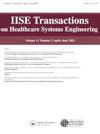Multi-label chain clustering-classification and regression predictive models for patient punctuality and turnaround time in outpatient primary care settings
IF 1.5
Q3 HEALTH CARE SCIENCES & SERVICES
IISE Transactions on Healthcare Systems Engineering
Pub Date : 2022-05-05
DOI:10.1080/24725579.2022.2068703
引用次数: 1
Abstract
Abstract This study develops two multi-label chain machine learning predictive models to anticipate patient punctuality and turnaround time. The first model uses an integrated model of clustering and classification where the check-in, service, and checkout times are clustered into three categories using the K-means algorithm. Then, patient punctuality and established clusters are used to develop a multi-label chain predictive model that utilizes Logistic Regression, Multi-Layer Perceptron, and tree-based classifiers. The second model predicts patient punctuality and turnaround time using a multi-label chain regression model that utilizes Linear Regression, Huber Regressor, ADR Regression, Multi-Layer Perceptron, and tree-based regressors. It was found that a patient’s age is a key driver for both patient punctuality and turnaround time. Also, there is a significant association between patient punctuality and turnaround time. The first proposed model predicted the punctuality and turnaround time with an average best F1-score of about 70.4% and 71.9%, respectively. The second model produced acceptable results with the best average R-squared of 0.67 for punctuality and 0.68 for turnaround time. The models can reduce the complexity and time of predicting several numerical outputs, enhance the interpretation of the results, and improve the understanding of the results by non-technical staff.多标签链聚类分类和回归预测模型的病人准时和周转时间在门诊初级保健设置
摘要:本研究开发了两个多标签链机器学习预测模型来预测患者的准时性和周转时间。第一个模型使用聚类和分类的集成模型,其中使用K-means算法将签入、服务和结帐时间聚为三类。然后,使用患者准时性和已建立的聚类来开发多标签链预测模型,该模型利用逻辑回归,多层感知器和基于树的分类器。第二个模型使用多标签链回归模型预测患者的准点率和转诊时间,该模型利用线性回归、Huber回归、ADR回归、多层感知器和基于树的回归。研究发现,患者的年龄是患者准时性和周转时间的关键驱动因素。此外,病人的准时性和周转时间之间也存在显著的关联。第一个模型预测准点率和周转时间的平均最佳f1得分分别约为70.4%和71.9%。第二个模型产生了可接受的结果,准点率的平均r平方为0.67,周转时间的平均r平方为0.68。该模型可以减少预测多个数值输出的复杂性和时间,增强对结果的解释,并提高非技术人员对结果的理解。
本文章由计算机程序翻译,如有差异,请以英文原文为准。
求助全文
约1分钟内获得全文
求助全文
来源期刊

IISE Transactions on Healthcare Systems Engineering
Social Sciences-Safety Research
CiteScore
3.10
自引率
0.00%
发文量
19
期刊介绍:
IISE Transactions on Healthcare Systems Engineering aims to foster the healthcare systems community by publishing high quality papers that have a strong methodological focus and direct applicability to healthcare systems. Published quarterly, the journal supports research that explores: · Healthcare Operations Management · Medical Decision Making · Socio-Technical Systems Analysis related to healthcare · Quality Engineering · Healthcare Informatics · Healthcare Policy We are looking forward to accepting submissions that document the development and use of industrial and systems engineering tools and techniques including: · Healthcare operations research · Healthcare statistics · Healthcare information systems · Healthcare work measurement · Human factors/ergonomics applied to healthcare systems Research that explores the integration of these tools and techniques with those from other engineering and medical disciplines are also featured. We encourage the submission of clinical notes, or practice notes, to show the impact of contributions that will be published. We also encourage authors to collect an impact statement from their clinical partners to show the impact of research in the clinical practices.
 求助内容:
求助内容: 应助结果提醒方式:
应助结果提醒方式:


